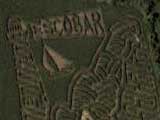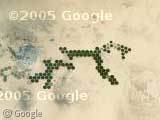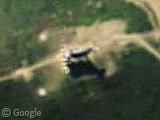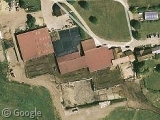Dairy Farming
Thursday, 26th February 2009 by Alex Turnbull
California's San Joaquin Valley is one of the most productive agricultural regions in the US, and in recent years has seen an expansion of the importance of dairy farming.
The US is the second largest dairy producer in the world, and California is responsible for more dairy produce than any other US state. Much of this output comes directly from the San Joaquin Valley - where today we're visiting some of the largest dairy farms on Earth.
There are dozens of dairy farms in the valley, but we're just going to look at one of the largest, where there could be as many as 20,000 cows on one single property.
Here we can see the loafing barns where the cows can take shelter. The largest of these might house up to 2,000 cattle each, and when seen from Street View the scale of the operation starts to become clear.
Further south we find the milking parlours, where on Street View I think we can see the cows being milked.
As you might imagine, feeding this number of animals is no small task, and the feed storage barns are absolutely gigantic. However the question I bet you're all wondering is "what happens to all the feed when it comes out the other end?"
The large brown pool on the west side of the property is the manure lagoon. Yes, a lagoon of cow poo. A regular dairy might require an acre of cropland to disperse the manure of just 5 cows, so you can imagine how much crop space you need for a herd of 20,000.1
Of course none of this is without cost to the environment. It's estimated that cattle farming is responsible for 18% of greenhouse gases, making it one of the most pressing environmental problems in the world.
Read more about Dairy Farming and the San Joaquin Valley at Wikipedia.
Thanks to ed, Dru Pollini, and Ronald.
-
Fortunately there's plenty to go around in the valley - zooming out just a little begins to give us an indication of the area that is given over to crops. ↩︎













I feel so sorry for American cows that have to eat corn. New Zealand cows live on open pastures and eat grass. If you looked at a satellite image of a New Zealand dairy farm it would be green. Of course, there is still the pollution, and there are some irresponsible farmers who allow the manure to run into streams and rivers, thus polluting them for everyone else. Plus dairy farms use a huge amount of water which leaves less for everyone else.
You are an idiot.
Explain why I am in idiot. I bet I know more about the American industrial food production system and the New Zealand food production system than you do. Perhaps you could back up your claim.
I’m not sure that this is actually a dairy – looks more like a feedlot to me. However, if you want truly frightening amounts of cattle, check out the Harris Ranch feedlot just east of I5 in Coalinga. This is notable because Harris Ranch is probably the only name-brand beef producer I can think of, and because anyone traveling I5 immediately can tell if they’re within a mile of the place – the odor is foul and persistent. Worse, there’s a Harris Ranch Restaurant nearby, and while the steak is good and cheap, you can’t drink anything where the water came out of the tap (meaning sodas) because the water is foul tasting too.
LadyKalessia is right. The Harris Ranch feedlot is just plain nasty. I just passed through there a few weeks ago going north on I5. Rolling up the windows and closing the vents on the car is useless. The smell penetrates metal. I can’t believe this area isn’t considered a biohazzard. I haven’t had any beef since and am not sure when I will again.
Except greenhouse gasses don’t do much. The only holes in the ozone are over the poles and their size change is measurably cyclical. Cattle operations are a necessity. Go thank the operators for their hard work.
Sigh.. Greenhouse gasses don’t deplete the ozone layer, you’re thinking of the CFC’s that were commonly used as refrigerants and as expellants in aerosol cans etc.
“Cattle operations are a necessity” – what utter bollocks! Shame on the operators and the consumers who greedily and selfishly guzzle dairy products and animal products.
Interesting, Yep. So you think that there is a connection between greenhouse gases and the ozone hole? I think the scientific community needs to be told!
Loving some of the Google Ads this post has thrown up! 🙂
Is that my milk yield I wonder? Sounds cheap!
Having grown up next to dairies and now as I drink my milk and enjoy my steak with my meteorology degree pondering atmospheric sciences and climatological studies, I knew upon opening this page I would see the ignorance or poorly informed comments from the masses. Educate yourself. Don’t let emotions get in the way of intellect and common sense. Do not be like sheep by letting other shepherds claiming to be all knowing tell you how things are. Most are wolves in sheep’s clothing.
Zach, who exactly are you talking to? If you know so much why not inform us? And why assume we are uneducated, I’m completing a PhD in science.
Petra I don’t think Zach is talking about a formal education, but instead informing yourself about Agriculture and Environmental issues. I think we can all be mislead by people who think they know what they are talking about (media perhaps). When in fact they have no knowledge about what happens on a farm or feedlot and only judge by a few bad apples. Without agriculture, the world starves. Remember that a farmers’ livelyhood depends on them being good stewards of the land. Good farmers care 365/24/7!
Actually quite a silly argument JP. Animal farming is not the only kind of farming available. Animal farming is usually NOT good farming.
Moronic commentary Zach.
Thanks for the stunning insight Walter! You contributed a lot to the conversation. No kidding animal farming is not the only form of agriculture. Very astute of you.
Unfortunately, the feedlots posted in this post pale in comparison to the sheer size of the CAFO’s (Concentrated Animal Feeding Operations) i’ve linked to below.
This one in Grand View, ID is considered the largest in the US (World?) by heads of cattle I believe:
View Placemark
These two behemoths in Greeley, CO beling to the Monfort Beef company:
View Placemark
View Placemark
This is the country’s biggest Slaughterhouse. Its a Chicken plant – Foster Farms Slaughterhouse in Livingston, CA
View Placemark